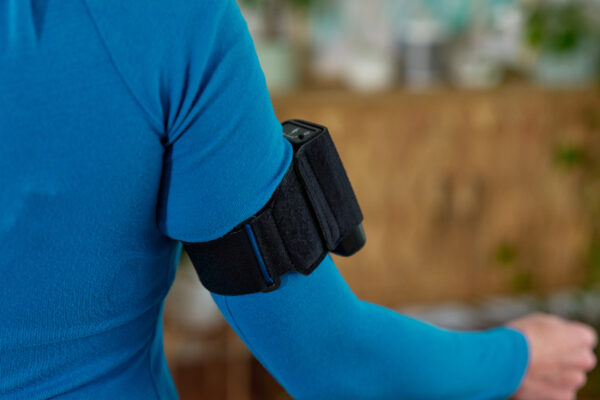
The FDA-cleared Fist Assist device
Patients suffering from Chronic Kidney Disease (CKD) who are progressing from stage 4 chronic disease to stage 5, End-Stage Renal Disease (ESRD), typically need dialysis when they reach stage 5. When that happens, they need their veins to be in good shape and specifically 2 or 3 mm or greater to receive proper treatment: they need good fistula creation, where an artery is connected to a vein in the arm so they can get dialysis. And a healthy vein size helps fistula placement, according to experts.
Many patients in this demographic are older — in their late 70s and 80s — and their veins may not meet the criteria for a good fistula due to age or trauma of past treatments using those veins. If they do not have suitable veins, the current standard of care is exercise to increase vein diameter, such as asking patients to squeeze a ball in the hand or making them clenching their fist.
However, patients often struggle to follow through with those exercises, making results inconsistent at best. And the stakes are high for the patient finding a way to get a suitable vein: Failure to do so ultimately results in placing a central venous catheter for dialysis, which is painful and comes with its own risks of infection and central vein stenosis.
Enter Las Vegas-based Fist Assist’s Model FA-1 device, a wearable arm massager that increases circulation, which is targeted to patients with chronic renal failure. Specifically, FA-1 is an i
“No company has ever given any passion or care for the needs of arm veins,” declared Tej Singh, CEO and founder of Fist Assist Devices, in an interview. “There has never been a company that has created this type of device for renal failure or infusion. We have a product where many people say to me, ‘Why didn’t I think of that?’”
There appear to be other approaches to creating fistula for hemodialysis patients.
Though effective, FA-1 is not a solution for the day of a procedure. To get the necessary benefit from the device, patients should wear it for 30 minutes in the morning and another 30 minutes in the evening for the four weeks leading up to any treatment or procedure — from blood draw to fistula placement to IV placement required for medication delivery. Arm veins are the entry point for so many key medical conditions, said Singh. Ideally patients would wear it for an hour each time for best results.
An FDA approved trial found Fist Assist’s Model FA-1 device effectively dilates the perforator vein, which could help with endoAVF placement and likely result in the both increased success rate of hemodialysis as well as endoAVF patency. EndoAVF is a new way to make elbow region fistulas with minimally invasive methods. EndoAVFs prove a safe option for hemodialysis, and a potential challenge in endoAVF placement is an inadequate perforator vein diameter, the trial explained. Ultimately, the trial declared Fist Assist’s Model FA-1 device to be safe, simple, effective, and cost-effective. As a result, it could increase the use of endoAVFs in the future, with potential cost-saving benefits globally for CKD, according to the trial and other studies.
In December 2021, Fist Assist received Breakthrough Device designation from the FDA for its wearable vein dilation device intended for End Stage Renal Disease (ESDR) patients.
FA-1 is an FDA 510k cleared device in the United States and works by increasing focal arm circulation via compressing the arm intermittently, with applications for improving outcomes for not only dialysis, but also blood draws and cancer care. The device is already bears the CE Mark and is being sold in India. Australia sales will shortly follow, according to Singh, for indications like vein dilation and vascular access maturation.
On May 1, Fist Assist expects to launch a crowdfunding round to raise capital for a formal sales launch. To date, family members have personally funded the company without any venture capital infusion, Singh said. That’s how much Singh believes in the product and its potential to revolutionize care for patients.
“We have bootstrapped this whole company to the point of sales and marketing. Talk about putting your money where your arm is, right?” he said.
Already Singh is thinking of the next iteration of the product, which will include a band that is compatible with running and other exercise, so patients have more mobility while wearing it.
Photo: Fist Assist








